Women's Workplace Equality in Australia: A Comprehensive Analysis
VerifiedAdded on 2022/09/07
|12
|2702
|13
Essay
AI Summary
This essay provides a comprehensive overview of women's workplace equality in Australia. It begins by defining gender discrimination and its manifestations in various aspects of life, including health, political opportunities, and domestic environments, with a specific focus on employment and wages. The essay delves into the causes of gender inequality in the workplace, exploring factors such as health disparities, political underrepresentation, and domestic abuse, alongside the historical evolution of gender roles in education. It then examines the legal safeguards provided by the Australian government to combat gender discrimination, including the Sex Discrimination Act 1984, the Fair Work Act 2009, the Workplace Gender Equality Act 2012, and the Gender Equality Bill (2018), as well as various organizational policies. The essay concludes by highlighting the ongoing challenges and the importance of continued efforts to promote gender equality in the Australian workplace, emphasizing the need for further legislative and policy developments to ensure a fair and equitable environment for all employees.
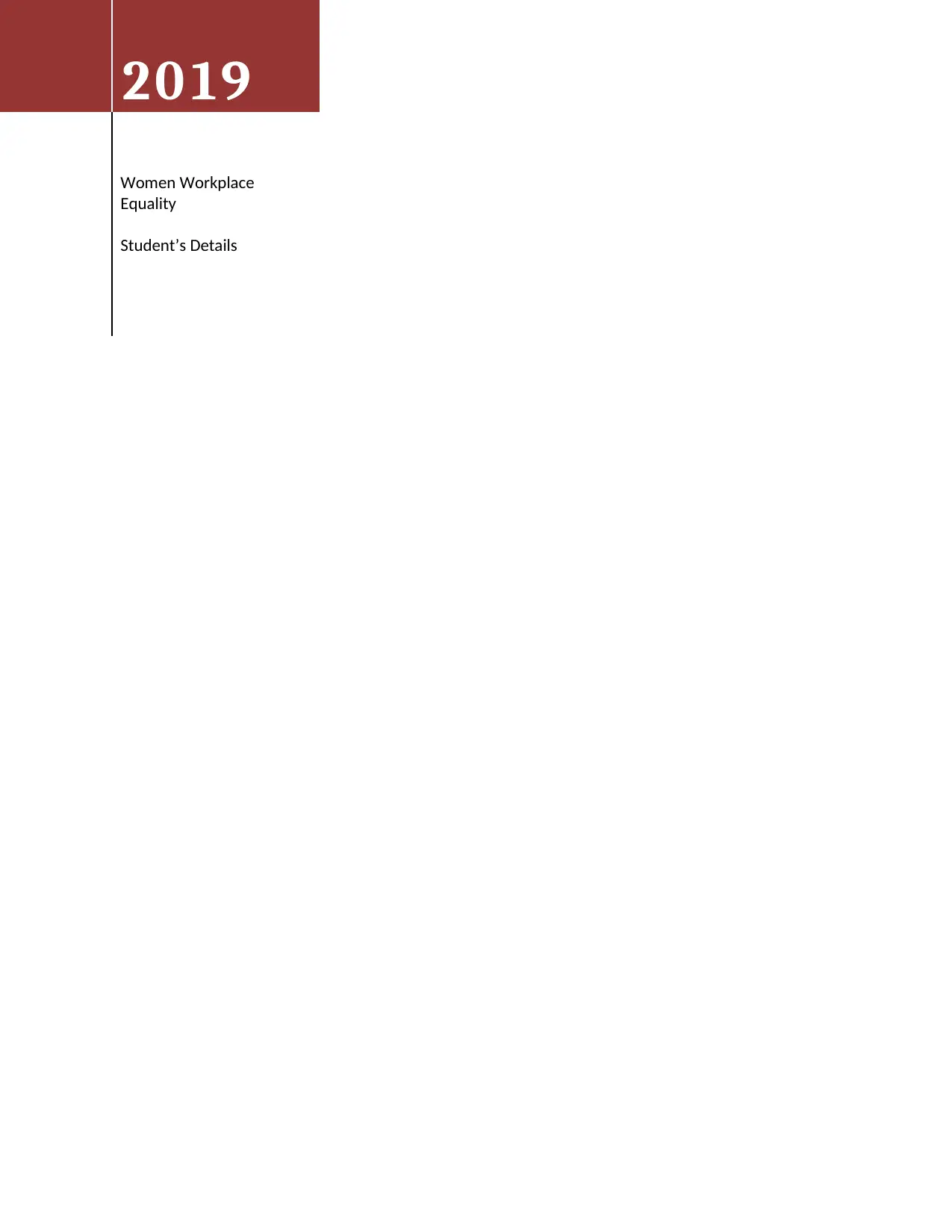
2019
Women Workplace
Equality
Student’s Details
Women Workplace
Equality
Student’s Details
Paraphrase This Document
Need a fresh take? Get an instant paraphrase of this document with our AI Paraphraser
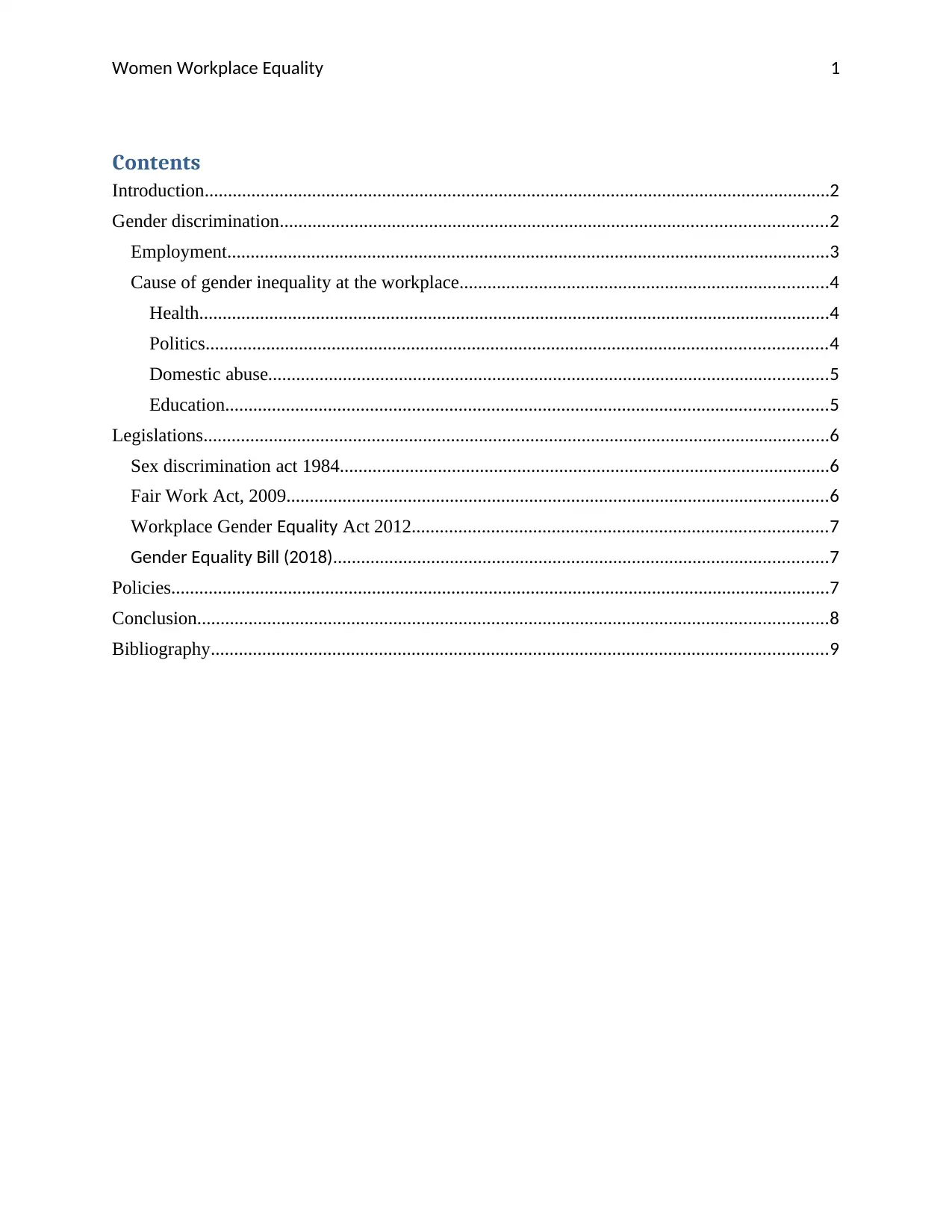
Women Workplace Equality 1
Contents
Introduction......................................................................................................................................2
Gender discrimination.....................................................................................................................2
Employment.................................................................................................................................3
Cause of gender inequality at the workplace...............................................................................4
Health.......................................................................................................................................4
Politics.....................................................................................................................................4
Domestic abuse........................................................................................................................5
Education.................................................................................................................................5
Legislations......................................................................................................................................6
Sex discrimination act 1984.........................................................................................................6
Fair Work Act, 2009....................................................................................................................6
Workplace Gender Equality Act 2012.........................................................................................7
Gender Equality Bill (2018)..........................................................................................................7
Policies.............................................................................................................................................7
Conclusion.......................................................................................................................................8
Bibliography....................................................................................................................................9
Contents
Introduction......................................................................................................................................2
Gender discrimination.....................................................................................................................2
Employment.................................................................................................................................3
Cause of gender inequality at the workplace...............................................................................4
Health.......................................................................................................................................4
Politics.....................................................................................................................................4
Domestic abuse........................................................................................................................5
Education.................................................................................................................................5
Legislations......................................................................................................................................6
Sex discrimination act 1984.........................................................................................................6
Fair Work Act, 2009....................................................................................................................6
Workplace Gender Equality Act 2012.........................................................................................7
Gender Equality Bill (2018)..........................................................................................................7
Policies.............................................................................................................................................7
Conclusion.......................................................................................................................................8
Bibliography....................................................................................................................................9
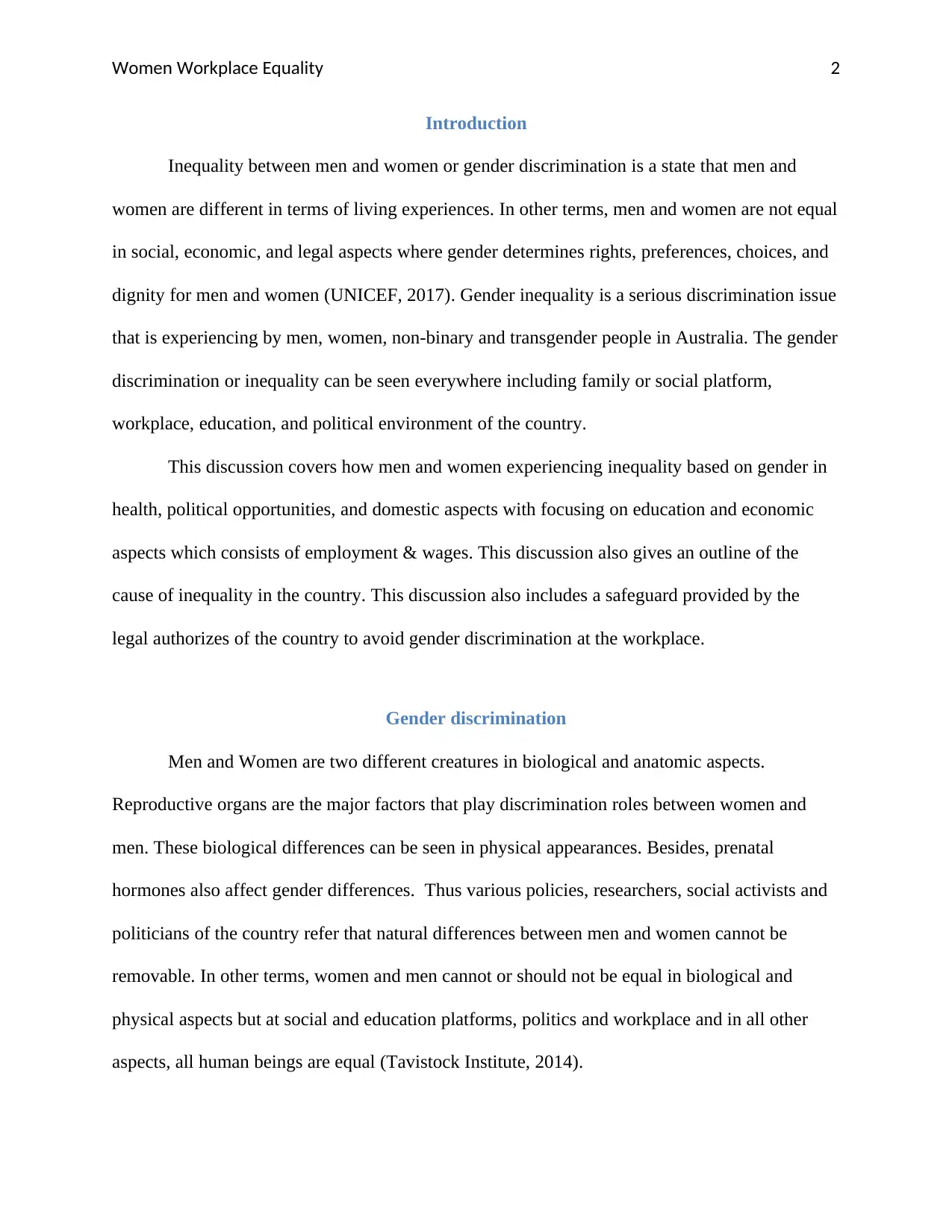
Women Workplace Equality 2
Introduction
Inequality between men and women or gender discrimination is a state that men and
women are different in terms of living experiences. In other terms, men and women are not equal
in social, economic, and legal aspects where gender determines rights, preferences, choices, and
dignity for men and women (UNICEF, 2017). Gender inequality is a serious discrimination issue
that is experiencing by men, women, non-binary and transgender people in Australia. The gender
discrimination or inequality can be seen everywhere including family or social platform,
workplace, education, and political environment of the country.
This discussion covers how men and women experiencing inequality based on gender in
health, political opportunities, and domestic aspects with focusing on education and economic
aspects which consists of employment & wages. This discussion also gives an outline of the
cause of inequality in the country. This discussion also includes a safeguard provided by the
legal authorizes of the country to avoid gender discrimination at the workplace.
Gender discrimination
Men and Women are two different creatures in biological and anatomic aspects.
Reproductive organs are the major factors that play discrimination roles between women and
men. These biological differences can be seen in physical appearances. Besides, prenatal
hormones also affect gender differences. Thus various policies, researchers, social activists and
politicians of the country refer that natural differences between men and women cannot be
removable. In other terms, women and men cannot or should not be equal in biological and
physical aspects but at social and education platforms, politics and workplace and in all other
aspects, all human beings are equal (Tavistock Institute, 2014).
Introduction
Inequality between men and women or gender discrimination is a state that men and
women are different in terms of living experiences. In other terms, men and women are not equal
in social, economic, and legal aspects where gender determines rights, preferences, choices, and
dignity for men and women (UNICEF, 2017). Gender inequality is a serious discrimination issue
that is experiencing by men, women, non-binary and transgender people in Australia. The gender
discrimination or inequality can be seen everywhere including family or social platform,
workplace, education, and political environment of the country.
This discussion covers how men and women experiencing inequality based on gender in
health, political opportunities, and domestic aspects with focusing on education and economic
aspects which consists of employment & wages. This discussion also gives an outline of the
cause of inequality in the country. This discussion also includes a safeguard provided by the
legal authorizes of the country to avoid gender discrimination at the workplace.
Gender discrimination
Men and Women are two different creatures in biological and anatomic aspects.
Reproductive organs are the major factors that play discrimination roles between women and
men. These biological differences can be seen in physical appearances. Besides, prenatal
hormones also affect gender differences. Thus various policies, researchers, social activists and
politicians of the country refer that natural differences between men and women cannot be
removable. In other terms, women and men cannot or should not be equal in biological and
physical aspects but at social and education platforms, politics and workplace and in all other
aspects, all human beings are equal (Tavistock Institute, 2014).
⊘ This is a preview!⊘
Do you want full access?
Subscribe today to unlock all pages.

Trusted by 1+ million students worldwide

Women Workplace Equality 3
Employment
Gender discrimination refers to adverse actions against a person or employee by
employer, peers, or polices by the organization. In legal terms such action may be threatening to
the employee, dismissing or injuring to an employee, less wages or payment for the same work,
demotion from the position and difference in the distribution of opportunities on the basis of
gender (FWO, 2019). For more than 40 years social activities are struggling to remove gender
discrimination at the workplace through formal and informal mediums, but sexual discrimination
or gender discrimination still exists at the workplace. This gender discrimination can be seen
easily in the country as unequal numbers of women for the leadership role in the organizations,
low wages for the same work, restrictions for women for some particulars jobs like defence or
military services or the jobs that required frequent travels, and many more (Stamarski & Hing,
2015).
As discussed above, in the country like Australia no more education difference exists.
Women in Australia are highly educated and qualified, despite they are less likely to achieve
leadership positions or comprises on wages at the workplace (Opencolleges website, 2019).
According to a survey report of Australian Government based on payment or wages, in last five
years, the gap between men's and women's payment is more than $25,717 that means the male
employee is earning on average $25,717 more money as compared to women employee
(Workplace Gender Equality Agency, 2018 ).
Financial services and insurance services have the largest pay gap, as men get more payment
than to women. Basic salary differences also exit more than 16.2 % that means a male employee
getting 16.2% more pay than female employees. Total remuneration for a female employee is
21.3% less than male employees across all industries in Australia (Workplace Gender Equality
Employment
Gender discrimination refers to adverse actions against a person or employee by
employer, peers, or polices by the organization. In legal terms such action may be threatening to
the employee, dismissing or injuring to an employee, less wages or payment for the same work,
demotion from the position and difference in the distribution of opportunities on the basis of
gender (FWO, 2019). For more than 40 years social activities are struggling to remove gender
discrimination at the workplace through formal and informal mediums, but sexual discrimination
or gender discrimination still exists at the workplace. This gender discrimination can be seen
easily in the country as unequal numbers of women for the leadership role in the organizations,
low wages for the same work, restrictions for women for some particulars jobs like defence or
military services or the jobs that required frequent travels, and many more (Stamarski & Hing,
2015).
As discussed above, in the country like Australia no more education difference exists.
Women in Australia are highly educated and qualified, despite they are less likely to achieve
leadership positions or comprises on wages at the workplace (Opencolleges website, 2019).
According to a survey report of Australian Government based on payment or wages, in last five
years, the gap between men's and women's payment is more than $25,717 that means the male
employee is earning on average $25,717 more money as compared to women employee
(Workplace Gender Equality Agency, 2018 ).
Financial services and insurance services have the largest pay gap, as men get more payment
than to women. Basic salary differences also exit more than 16.2 % that means a male employee
getting 16.2% more pay than female employees. Total remuneration for a female employee is
21.3% less than male employees across all industries in Australia (Workplace Gender Equality
Paraphrase This Document
Need a fresh take? Get an instant paraphrase of this document with our AI Paraphraser
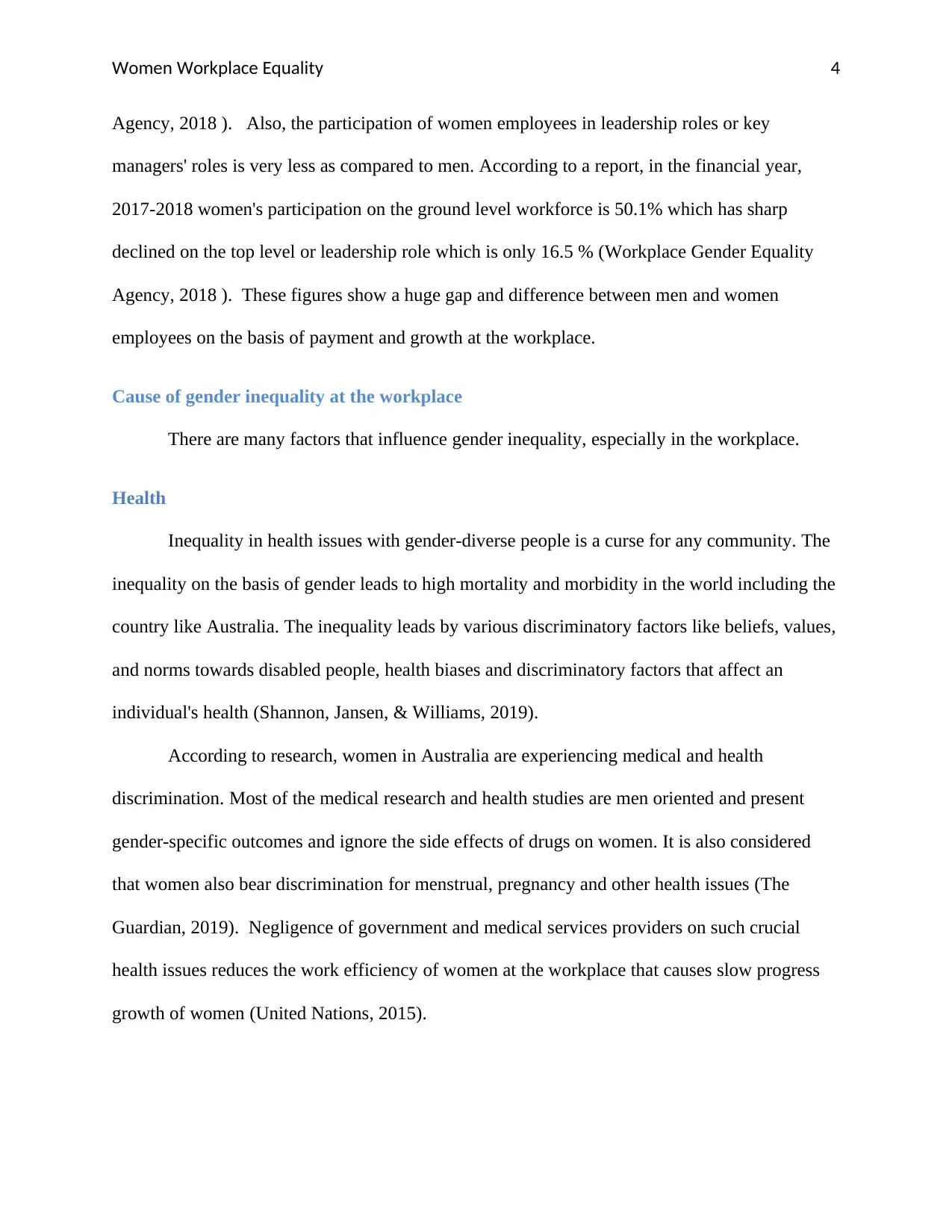
Women Workplace Equality 4
Agency, 2018 ). Also, the participation of women employees in leadership roles or key
managers' roles is very less as compared to men. According to a report, in the financial year,
2017-2018 women's participation on the ground level workforce is 50.1% which has sharp
declined on the top level or leadership role which is only 16.5 % (Workplace Gender Equality
Agency, 2018 ). These figures show a huge gap and difference between men and women
employees on the basis of payment and growth at the workplace.
Cause of gender inequality at the workplace
There are many factors that influence gender inequality, especially in the workplace.
Health
Inequality in health issues with gender-diverse people is a curse for any community. The
inequality on the basis of gender leads to high mortality and morbidity in the world including the
country like Australia. The inequality leads by various discriminatory factors like beliefs, values,
and norms towards disabled people, health biases and discriminatory factors that affect an
individual's health (Shannon, Jansen, & Williams, 2019).
According to research, women in Australia are experiencing medical and health
discrimination. Most of the medical research and health studies are men oriented and present
gender-specific outcomes and ignore the side effects of drugs on women. It is also considered
that women also bear discrimination for menstrual, pregnancy and other health issues (The
Guardian, 2019). Negligence of government and medical services providers on such crucial
health issues reduces the work efficiency of women at the workplace that causes slow progress
growth of women (United Nations, 2015).
Agency, 2018 ). Also, the participation of women employees in leadership roles or key
managers' roles is very less as compared to men. According to a report, in the financial year,
2017-2018 women's participation on the ground level workforce is 50.1% which has sharp
declined on the top level or leadership role which is only 16.5 % (Workplace Gender Equality
Agency, 2018 ). These figures show a huge gap and difference between men and women
employees on the basis of payment and growth at the workplace.
Cause of gender inequality at the workplace
There are many factors that influence gender inequality, especially in the workplace.
Health
Inequality in health issues with gender-diverse people is a curse for any community. The
inequality on the basis of gender leads to high mortality and morbidity in the world including the
country like Australia. The inequality leads by various discriminatory factors like beliefs, values,
and norms towards disabled people, health biases and discriminatory factors that affect an
individual's health (Shannon, Jansen, & Williams, 2019).
According to research, women in Australia are experiencing medical and health
discrimination. Most of the medical research and health studies are men oriented and present
gender-specific outcomes and ignore the side effects of drugs on women. It is also considered
that women also bear discrimination for menstrual, pregnancy and other health issues (The
Guardian, 2019). Negligence of government and medical services providers on such crucial
health issues reduces the work efficiency of women at the workplace that causes slow progress
growth of women (United Nations, 2015).
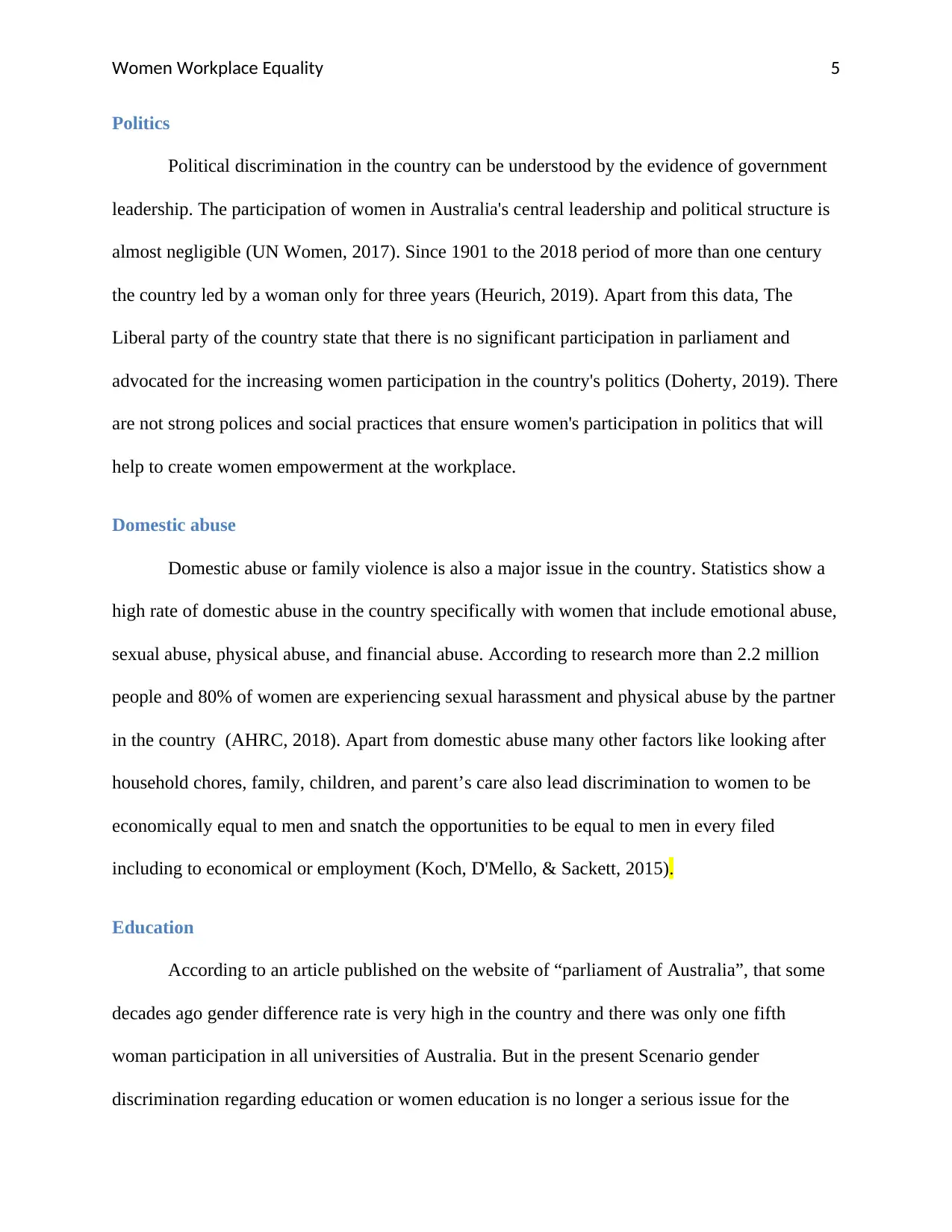
Women Workplace Equality 5
Politics
Political discrimination in the country can be understood by the evidence of government
leadership. The participation of women in Australia's central leadership and political structure is
almost negligible (UN Women, 2017). Since 1901 to the 2018 period of more than one century
the country led by a woman only for three years (Heurich, 2019). Apart from this data, The
Liberal party of the country state that there is no significant participation in parliament and
advocated for the increasing women participation in the country's politics (Doherty, 2019). There
are not strong polices and social practices that ensure women's participation in politics that will
help to create women empowerment at the workplace.
Domestic abuse
Domestic abuse or family violence is also a major issue in the country. Statistics show a
high rate of domestic abuse in the country specifically with women that include emotional abuse,
sexual abuse, physical abuse, and financial abuse. According to research more than 2.2 million
people and 80% of women are experiencing sexual harassment and physical abuse by the partner
in the country (AHRC, 2018). Apart from domestic abuse many other factors like looking after
household chores, family, children, and parent’s care also lead discrimination to women to be
economically equal to men and snatch the opportunities to be equal to men in every filed
including to economical or employment (Koch, D'Mello, & Sackett, 2015).
Education
According to an article published on the website of “parliament of Australia”, that some
decades ago gender difference rate is very high in the country and there was only one fifth
woman participation in all universities of Australia. But in the present Scenario gender
discrimination regarding education or women education is no longer a serious issue for the
Politics
Political discrimination in the country can be understood by the evidence of government
leadership. The participation of women in Australia's central leadership and political structure is
almost negligible (UN Women, 2017). Since 1901 to the 2018 period of more than one century
the country led by a woman only for three years (Heurich, 2019). Apart from this data, The
Liberal party of the country state that there is no significant participation in parliament and
advocated for the increasing women participation in the country's politics (Doherty, 2019). There
are not strong polices and social practices that ensure women's participation in politics that will
help to create women empowerment at the workplace.
Domestic abuse
Domestic abuse or family violence is also a major issue in the country. Statistics show a
high rate of domestic abuse in the country specifically with women that include emotional abuse,
sexual abuse, physical abuse, and financial abuse. According to research more than 2.2 million
people and 80% of women are experiencing sexual harassment and physical abuse by the partner
in the country (AHRC, 2018). Apart from domestic abuse many other factors like looking after
household chores, family, children, and parent’s care also lead discrimination to women to be
economically equal to men and snatch the opportunities to be equal to men in every filed
including to economical or employment (Koch, D'Mello, & Sackett, 2015).
Education
According to an article published on the website of “parliament of Australia”, that some
decades ago gender difference rate is very high in the country and there was only one fifth
woman participation in all universities of Australia. But in the present Scenario gender
discrimination regarding education or women education is no longer a serious issue for the
⊘ This is a preview!⊘
Do you want full access?
Subscribe today to unlock all pages.

Trusted by 1+ million students worldwide
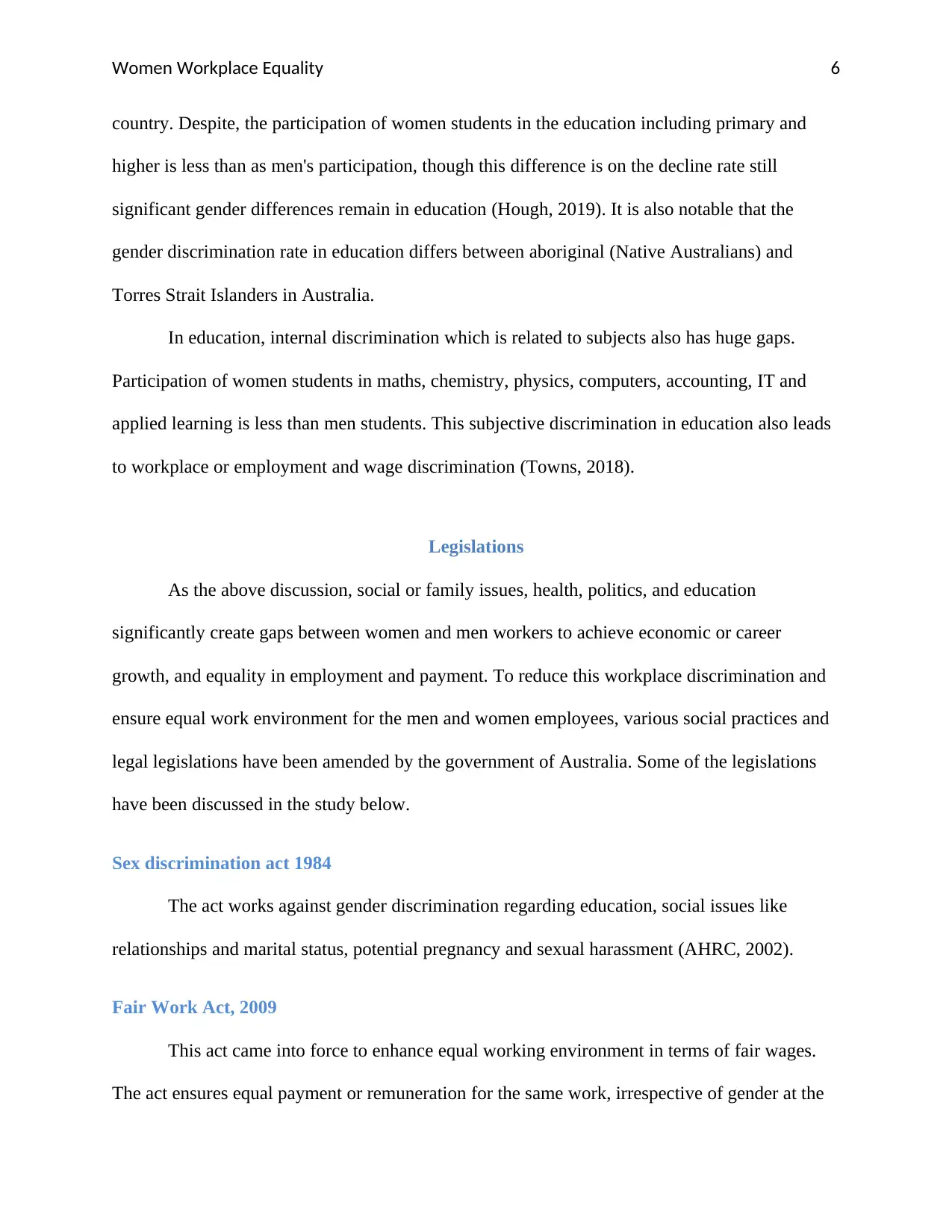
Women Workplace Equality 6
country. Despite, the participation of women students in the education including primary and
higher is less than as men's participation, though this difference is on the decline rate still
significant gender differences remain in education (Hough, 2019). It is also notable that the
gender discrimination rate in education differs between aboriginal (Native Australians) and
Torres Strait Islanders in Australia.
In education, internal discrimination which is related to subjects also has huge gaps.
Participation of women students in maths, chemistry, physics, computers, accounting, IT and
applied learning is less than men students. This subjective discrimination in education also leads
to workplace or employment and wage discrimination (Towns, 2018).
Legislations
As the above discussion, social or family issues, health, politics, and education
significantly create gaps between women and men workers to achieve economic or career
growth, and equality in employment and payment. To reduce this workplace discrimination and
ensure equal work environment for the men and women employees, various social practices and
legal legislations have been amended by the government of Australia. Some of the legislations
have been discussed in the study below.
Sex discrimination act 1984
The act works against gender discrimination regarding education, social issues like
relationships and marital status, potential pregnancy and sexual harassment (AHRC, 2002).
Fair Work Act, 2009
This act came into force to enhance equal working environment in terms of fair wages.
The act ensures equal payment or remuneration for the same work, irrespective of gender at the
country. Despite, the participation of women students in the education including primary and
higher is less than as men's participation, though this difference is on the decline rate still
significant gender differences remain in education (Hough, 2019). It is also notable that the
gender discrimination rate in education differs between aboriginal (Native Australians) and
Torres Strait Islanders in Australia.
In education, internal discrimination which is related to subjects also has huge gaps.
Participation of women students in maths, chemistry, physics, computers, accounting, IT and
applied learning is less than men students. This subjective discrimination in education also leads
to workplace or employment and wage discrimination (Towns, 2018).
Legislations
As the above discussion, social or family issues, health, politics, and education
significantly create gaps between women and men workers to achieve economic or career
growth, and equality in employment and payment. To reduce this workplace discrimination and
ensure equal work environment for the men and women employees, various social practices and
legal legislations have been amended by the government of Australia. Some of the legislations
have been discussed in the study below.
Sex discrimination act 1984
The act works against gender discrimination regarding education, social issues like
relationships and marital status, potential pregnancy and sexual harassment (AHRC, 2002).
Fair Work Act, 2009
This act came into force to enhance equal working environment in terms of fair wages.
The act ensures equal payment or remuneration for the same work, irrespective of gender at the
Paraphrase This Document
Need a fresh take? Get an instant paraphrase of this document with our AI Paraphraser
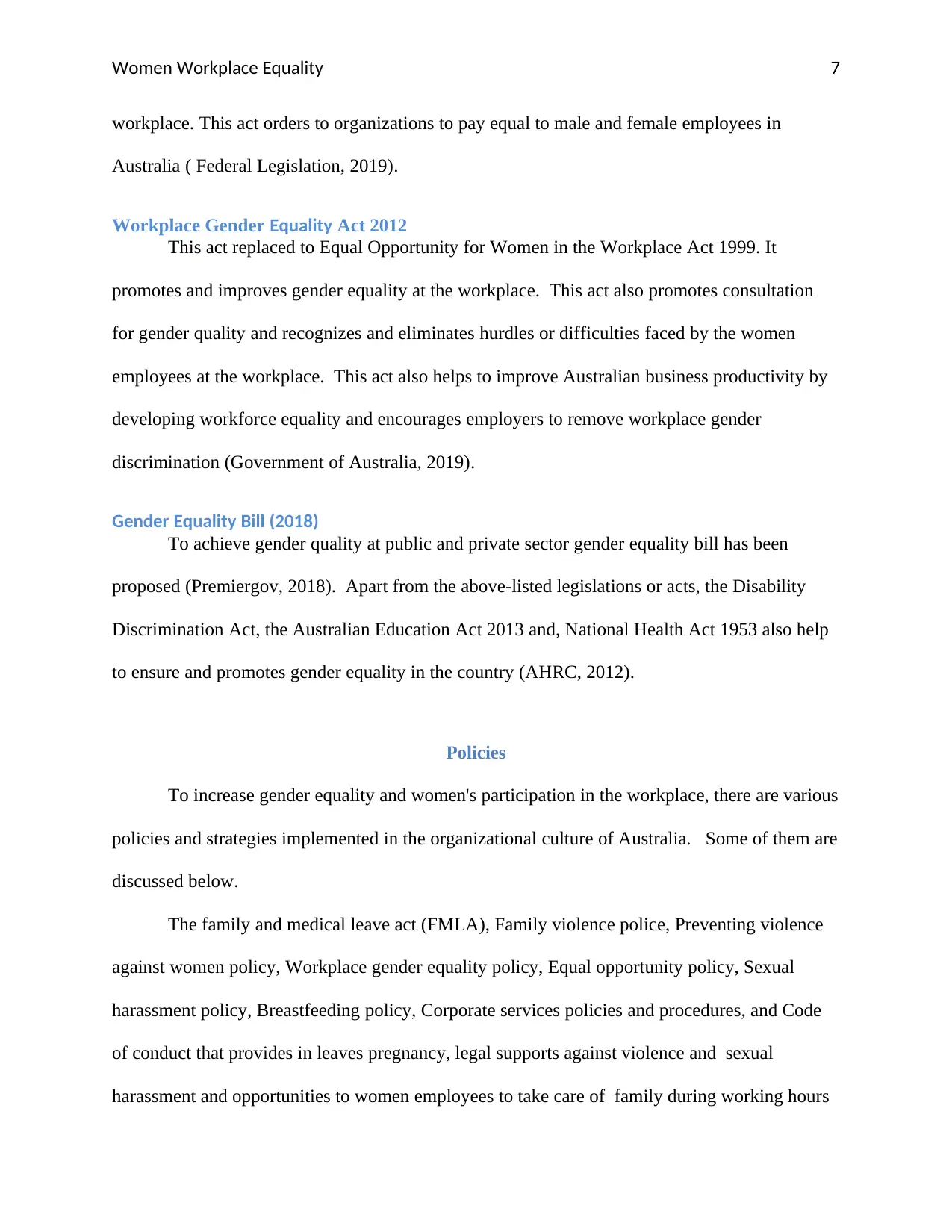
Women Workplace Equality 7
workplace. This act orders to organizations to pay equal to male and female employees in
Australia ( Federal Legislation, 2019).
Workplace Gender Equality Act 2012
This act replaced to Equal Opportunity for Women in the Workplace Act 1999. It
promotes and improves gender equality at the workplace. This act also promotes consultation
for gender quality and recognizes and eliminates hurdles or difficulties faced by the women
employees at the workplace. This act also helps to improve Australian business productivity by
developing workforce equality and encourages employers to remove workplace gender
discrimination (Government of Australia, 2019).
Gender Equality Bill (2018)
To achieve gender quality at public and private sector gender equality bill has been
proposed (Premiergov, 2018). Apart from the above-listed legislations or acts, the Disability
Discrimination Act, the Australian Education Act 2013 and, National Health Act 1953 also help
to ensure and promotes gender equality in the country (AHRC, 2012).
Policies
To increase gender equality and women's participation in the workplace, there are various
policies and strategies implemented in the organizational culture of Australia. Some of them are
discussed below.
The family and medical leave act (FMLA), Family violence police, Preventing violence
against women policy, Workplace gender equality policy, Equal opportunity policy, Sexual
harassment policy, Breastfeeding policy, Corporate services policies and procedures, and Code
of conduct that provides in leaves pregnancy, legal supports against violence and sexual
harassment and opportunities to women employees to take care of family during working hours
workplace. This act orders to organizations to pay equal to male and female employees in
Australia ( Federal Legislation, 2019).
Workplace Gender Equality Act 2012
This act replaced to Equal Opportunity for Women in the Workplace Act 1999. It
promotes and improves gender equality at the workplace. This act also promotes consultation
for gender quality and recognizes and eliminates hurdles or difficulties faced by the women
employees at the workplace. This act also helps to improve Australian business productivity by
developing workforce equality and encourages employers to remove workplace gender
discrimination (Government of Australia, 2019).
Gender Equality Bill (2018)
To achieve gender quality at public and private sector gender equality bill has been
proposed (Premiergov, 2018). Apart from the above-listed legislations or acts, the Disability
Discrimination Act, the Australian Education Act 2013 and, National Health Act 1953 also help
to ensure and promotes gender equality in the country (AHRC, 2012).
Policies
To increase gender equality and women's participation in the workplace, there are various
policies and strategies implemented in the organizational culture of Australia. Some of them are
discussed below.
The family and medical leave act (FMLA), Family violence police, Preventing violence
against women policy, Workplace gender equality policy, Equal opportunity policy, Sexual
harassment policy, Breastfeeding policy, Corporate services policies and procedures, and Code
of conduct that provides in leaves pregnancy, legal supports against violence and sexual
harassment and opportunities to women employees to take care of family during working hours
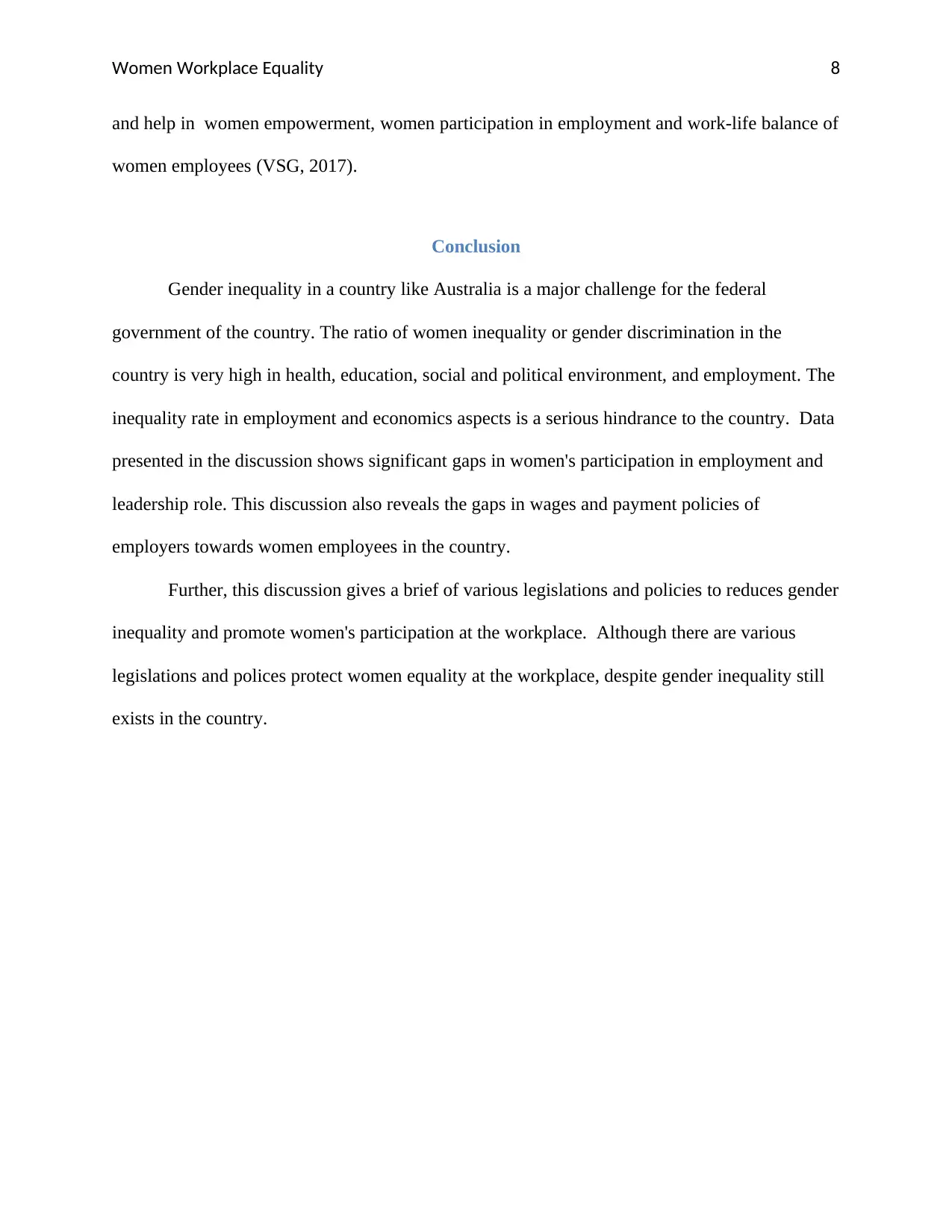
Women Workplace Equality 8
and help in women empowerment, women participation in employment and work-life balance of
women employees (VSG, 2017).
Conclusion
Gender inequality in a country like Australia is a major challenge for the federal
government of the country. The ratio of women inequality or gender discrimination in the
country is very high in health, education, social and political environment, and employment. The
inequality rate in employment and economics aspects is a serious hindrance to the country. Data
presented in the discussion shows significant gaps in women's participation in employment and
leadership role. This discussion also reveals the gaps in wages and payment policies of
employers towards women employees in the country.
Further, this discussion gives a brief of various legislations and policies to reduces gender
inequality and promote women's participation at the workplace. Although there are various
legislations and polices protect women equality at the workplace, despite gender inequality still
exists in the country.
and help in women empowerment, women participation in employment and work-life balance of
women employees (VSG, 2017).
Conclusion
Gender inequality in a country like Australia is a major challenge for the federal
government of the country. The ratio of women inequality or gender discrimination in the
country is very high in health, education, social and political environment, and employment. The
inequality rate in employment and economics aspects is a serious hindrance to the country. Data
presented in the discussion shows significant gaps in women's participation in employment and
leadership role. This discussion also reveals the gaps in wages and payment policies of
employers towards women employees in the country.
Further, this discussion gives a brief of various legislations and policies to reduces gender
inequality and promote women's participation at the workplace. Although there are various
legislations and polices protect women equality at the workplace, despite gender inequality still
exists in the country.
⊘ This is a preview!⊘
Do you want full access?
Subscribe today to unlock all pages.

Trusted by 1+ million students worldwide
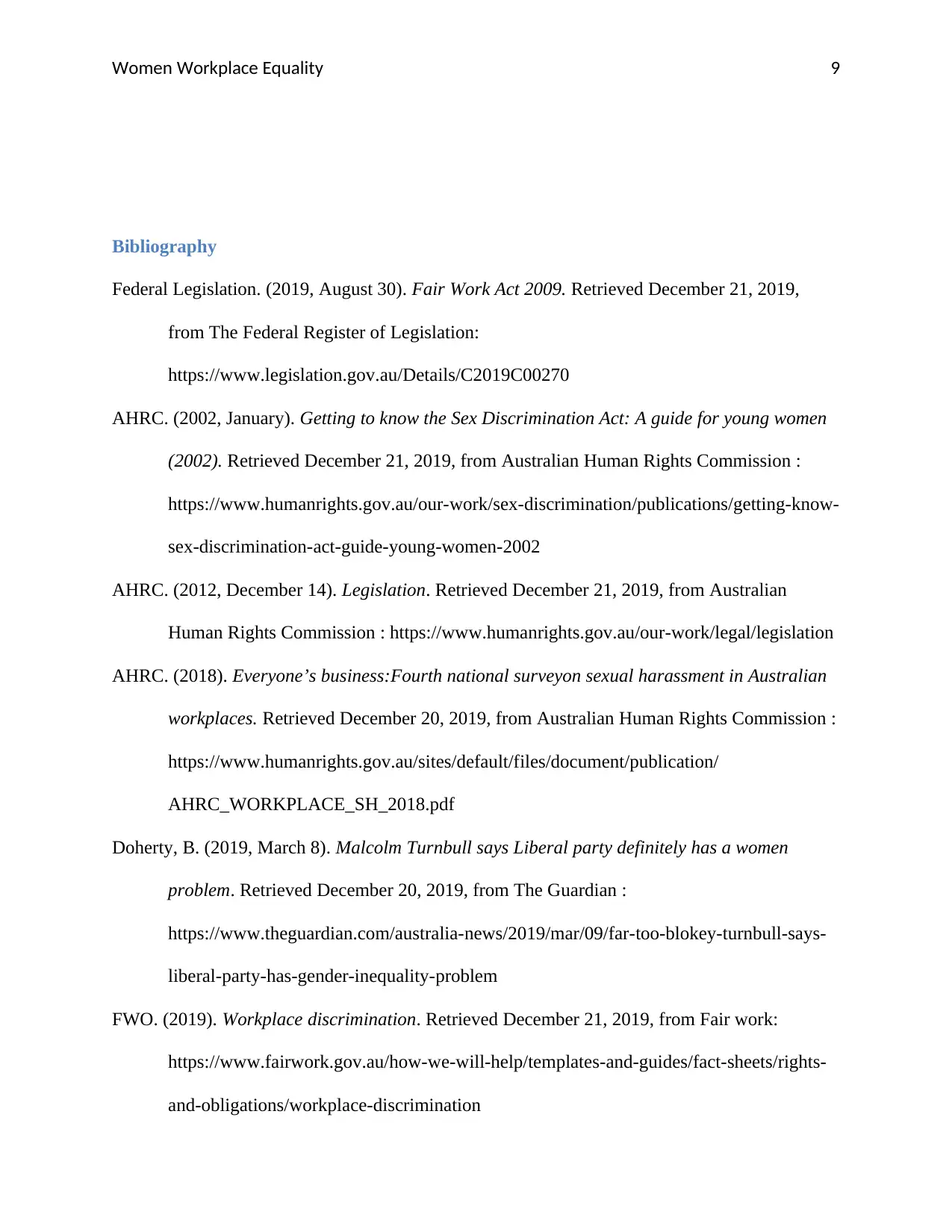
Women Workplace Equality 9
Bibliography
Federal Legislation. (2019, August 30). Fair Work Act 2009. Retrieved December 21, 2019,
from The Federal Register of Legislation:
https://www.legislation.gov.au/Details/C2019C00270
AHRC. (2002, January). Getting to know the Sex Discrimination Act: A guide for young women
(2002). Retrieved December 21, 2019, from Australian Human Rights Commission :
https://www.humanrights.gov.au/our-work/sex-discrimination/publications/getting-know-
sex-discrimination-act-guide-young-women-2002
AHRC. (2012, December 14). Legislation. Retrieved December 21, 2019, from Australian
Human Rights Commission : https://www.humanrights.gov.au/our-work/legal/legislation
AHRC. (2018). Everyone’s business:Fourth national surveyon sexual harassment in Australian
workplaces. Retrieved December 20, 2019, from Australian Human Rights Commission :
https://www.humanrights.gov.au/sites/default/files/document/publication/
AHRC_WORKPLACE_SH_2018.pdf
Doherty, B. (2019, March 8). Malcolm Turnbull says Liberal party definitely has a women
problem. Retrieved December 20, 2019, from The Guardian :
https://www.theguardian.com/australia-news/2019/mar/09/far-too-blokey-turnbull-says-
liberal-party-has-gender-inequality-problem
FWO. (2019). Workplace discrimination. Retrieved December 21, 2019, from Fair work:
https://www.fairwork.gov.au/how-we-will-help/templates-and-guides/fact-sheets/rights-
and-obligations/workplace-discrimination
Bibliography
Federal Legislation. (2019, August 30). Fair Work Act 2009. Retrieved December 21, 2019,
from The Federal Register of Legislation:
https://www.legislation.gov.au/Details/C2019C00270
AHRC. (2002, January). Getting to know the Sex Discrimination Act: A guide for young women
(2002). Retrieved December 21, 2019, from Australian Human Rights Commission :
https://www.humanrights.gov.au/our-work/sex-discrimination/publications/getting-know-
sex-discrimination-act-guide-young-women-2002
AHRC. (2012, December 14). Legislation. Retrieved December 21, 2019, from Australian
Human Rights Commission : https://www.humanrights.gov.au/our-work/legal/legislation
AHRC. (2018). Everyone’s business:Fourth national surveyon sexual harassment in Australian
workplaces. Retrieved December 20, 2019, from Australian Human Rights Commission :
https://www.humanrights.gov.au/sites/default/files/document/publication/
AHRC_WORKPLACE_SH_2018.pdf
Doherty, B. (2019, March 8). Malcolm Turnbull says Liberal party definitely has a women
problem. Retrieved December 20, 2019, from The Guardian :
https://www.theguardian.com/australia-news/2019/mar/09/far-too-blokey-turnbull-says-
liberal-party-has-gender-inequality-problem
FWO. (2019). Workplace discrimination. Retrieved December 21, 2019, from Fair work:
https://www.fairwork.gov.au/how-we-will-help/templates-and-guides/fact-sheets/rights-
and-obligations/workplace-discrimination
Paraphrase This Document
Need a fresh take? Get an instant paraphrase of this document with our AI Paraphraser
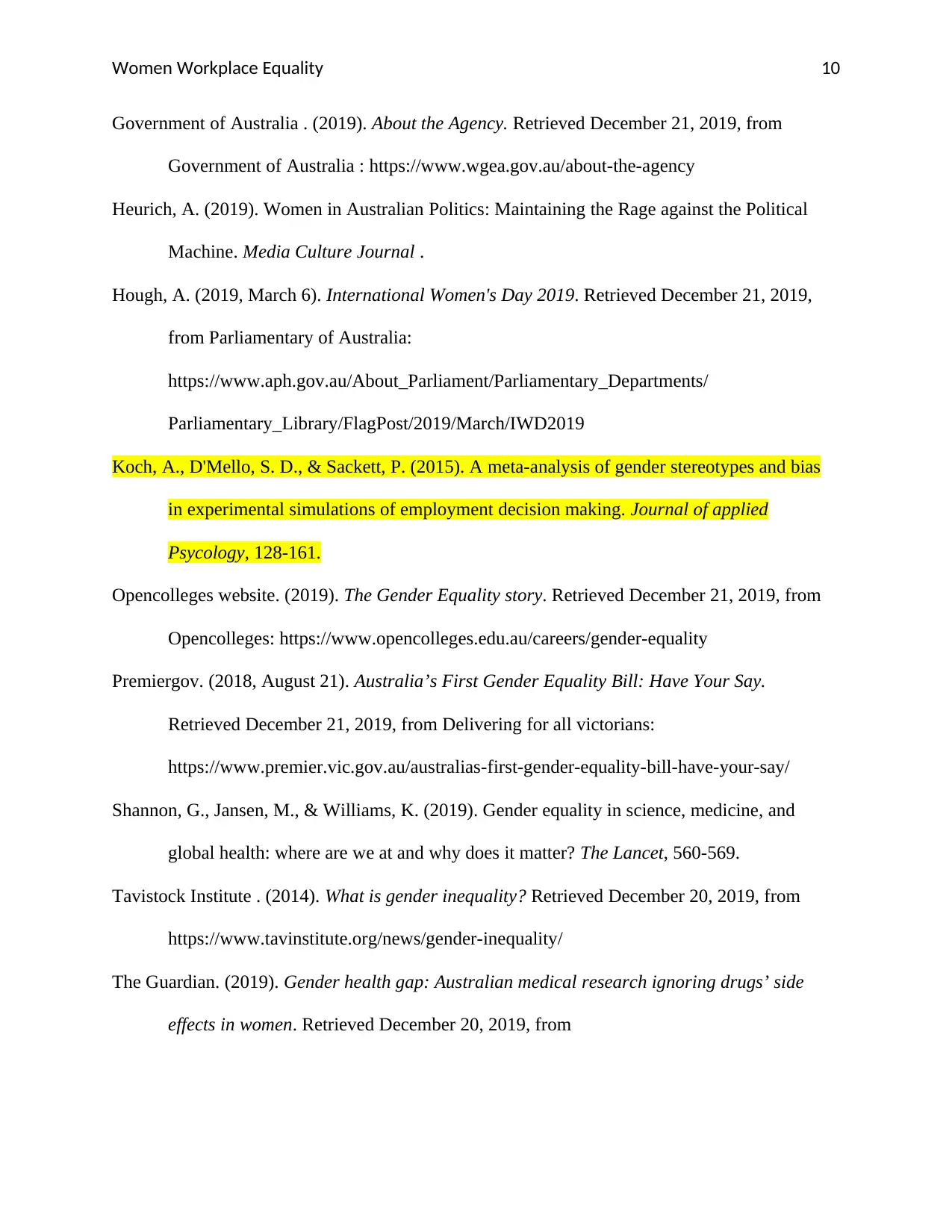
Women Workplace Equality 10
Government of Australia . (2019). About the Agency. Retrieved December 21, 2019, from
Government of Australia : https://www.wgea.gov.au/about-the-agency
Heurich, A. (2019). Women in Australian Politics: Maintaining the Rage against the Political
Machine. Media Culture Journal .
Hough, A. (2019, March 6). International Women's Day 2019. Retrieved December 21, 2019,
from Parliamentary of Australia:
https://www.aph.gov.au/About_Parliament/Parliamentary_Departments/
Parliamentary_Library/FlagPost/2019/March/IWD2019
Koch, A., D'Mello, S. D., & Sackett, P. (2015). A meta-analysis of gender stereotypes and bias
in experimental simulations of employment decision making. Journal of applied
Psycology, 128-161.
Opencolleges website. (2019). The Gender Equality story. Retrieved December 21, 2019, from
Opencolleges: https://www.opencolleges.edu.au/careers/gender-equality
Premiergov. (2018, August 21). Australia’s First Gender Equality Bill: Have Your Say.
Retrieved December 21, 2019, from Delivering for all victorians:
https://www.premier.vic.gov.au/australias-first-gender-equality-bill-have-your-say/
Shannon, G., Jansen, M., & Williams, K. (2019). Gender equality in science, medicine, and
global health: where are we at and why does it matter? The Lancet, 560-569.
Tavistock Institute . (2014). What is gender inequality? Retrieved December 20, 2019, from
https://www.tavinstitute.org/news/gender-inequality/
The Guardian. (2019). Gender health gap: Australian medical research ignoring drugs’ side
effects in women. Retrieved December 20, 2019, from
Government of Australia . (2019). About the Agency. Retrieved December 21, 2019, from
Government of Australia : https://www.wgea.gov.au/about-the-agency
Heurich, A. (2019). Women in Australian Politics: Maintaining the Rage against the Political
Machine. Media Culture Journal .
Hough, A. (2019, March 6). International Women's Day 2019. Retrieved December 21, 2019,
from Parliamentary of Australia:
https://www.aph.gov.au/About_Parliament/Parliamentary_Departments/
Parliamentary_Library/FlagPost/2019/March/IWD2019
Koch, A., D'Mello, S. D., & Sackett, P. (2015). A meta-analysis of gender stereotypes and bias
in experimental simulations of employment decision making. Journal of applied
Psycology, 128-161.
Opencolleges website. (2019). The Gender Equality story. Retrieved December 21, 2019, from
Opencolleges: https://www.opencolleges.edu.au/careers/gender-equality
Premiergov. (2018, August 21). Australia’s First Gender Equality Bill: Have Your Say.
Retrieved December 21, 2019, from Delivering for all victorians:
https://www.premier.vic.gov.au/australias-first-gender-equality-bill-have-your-say/
Shannon, G., Jansen, M., & Williams, K. (2019). Gender equality in science, medicine, and
global health: where are we at and why does it matter? The Lancet, 560-569.
Tavistock Institute . (2014). What is gender inequality? Retrieved December 20, 2019, from
https://www.tavinstitute.org/news/gender-inequality/
The Guardian. (2019). Gender health gap: Australian medical research ignoring drugs’ side
effects in women. Retrieved December 20, 2019, from
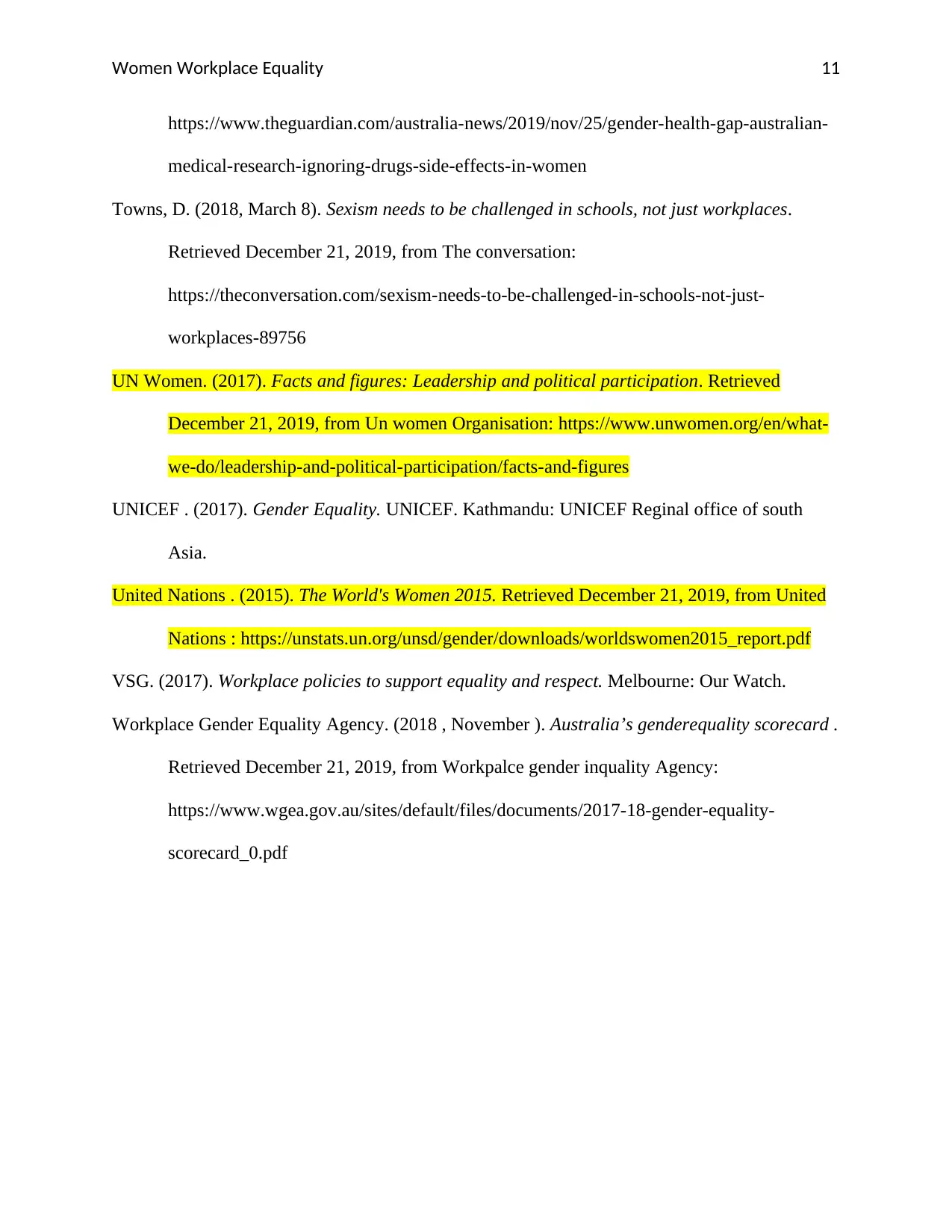
Women Workplace Equality 11
https://www.theguardian.com/australia-news/2019/nov/25/gender-health-gap-australian-
medical-research-ignoring-drugs-side-effects-in-women
Towns, D. (2018, March 8). Sexism needs to be challenged in schools, not just workplaces.
Retrieved December 21, 2019, from The conversation:
https://theconversation.com/sexism-needs-to-be-challenged-in-schools-not-just-
workplaces-89756
UN Women. (2017). Facts and figures: Leadership and political participation. Retrieved
December 21, 2019, from Un women Organisation: https://www.unwomen.org/en/what-
we-do/leadership-and-political-participation/facts-and-figures
UNICEF . (2017). Gender Equality. UNICEF. Kathmandu: UNICEF Reginal office of south
Asia.
United Nations . (2015). The World's Women 2015. Retrieved December 21, 2019, from United
Nations : https://unstats.un.org/unsd/gender/downloads/worldswomen2015_report.pdf
VSG. (2017). Workplace policies to support equality and respect. Melbourne: Our Watch.
Workplace Gender Equality Agency. (2018 , November ). Australia’s genderequality scorecard .
Retrieved December 21, 2019, from Workpalce gender inquality Agency:
https://www.wgea.gov.au/sites/default/files/documents/2017-18-gender-equality-
scorecard_0.pdf
https://www.theguardian.com/australia-news/2019/nov/25/gender-health-gap-australian-
medical-research-ignoring-drugs-side-effects-in-women
Towns, D. (2018, March 8). Sexism needs to be challenged in schools, not just workplaces.
Retrieved December 21, 2019, from The conversation:
https://theconversation.com/sexism-needs-to-be-challenged-in-schools-not-just-
workplaces-89756
UN Women. (2017). Facts and figures: Leadership and political participation. Retrieved
December 21, 2019, from Un women Organisation: https://www.unwomen.org/en/what-
we-do/leadership-and-political-participation/facts-and-figures
UNICEF . (2017). Gender Equality. UNICEF. Kathmandu: UNICEF Reginal office of south
Asia.
United Nations . (2015). The World's Women 2015. Retrieved December 21, 2019, from United
Nations : https://unstats.un.org/unsd/gender/downloads/worldswomen2015_report.pdf
VSG. (2017). Workplace policies to support equality and respect. Melbourne: Our Watch.
Workplace Gender Equality Agency. (2018 , November ). Australia’s genderequality scorecard .
Retrieved December 21, 2019, from Workpalce gender inquality Agency:
https://www.wgea.gov.au/sites/default/files/documents/2017-18-gender-equality-
scorecard_0.pdf
⊘ This is a preview!⊘
Do you want full access?
Subscribe today to unlock all pages.

Trusted by 1+ million students worldwide
1 out of 12
Related Documents
Your All-in-One AI-Powered Toolkit for Academic Success.
+13062052269
info@desklib.com
Available 24*7 on WhatsApp / Email
![[object Object]](/_next/static/media/star-bottom.7253800d.svg)
Unlock your academic potential
Copyright © 2020–2025 A2Z Services. All Rights Reserved. Developed and managed by ZUCOL.





